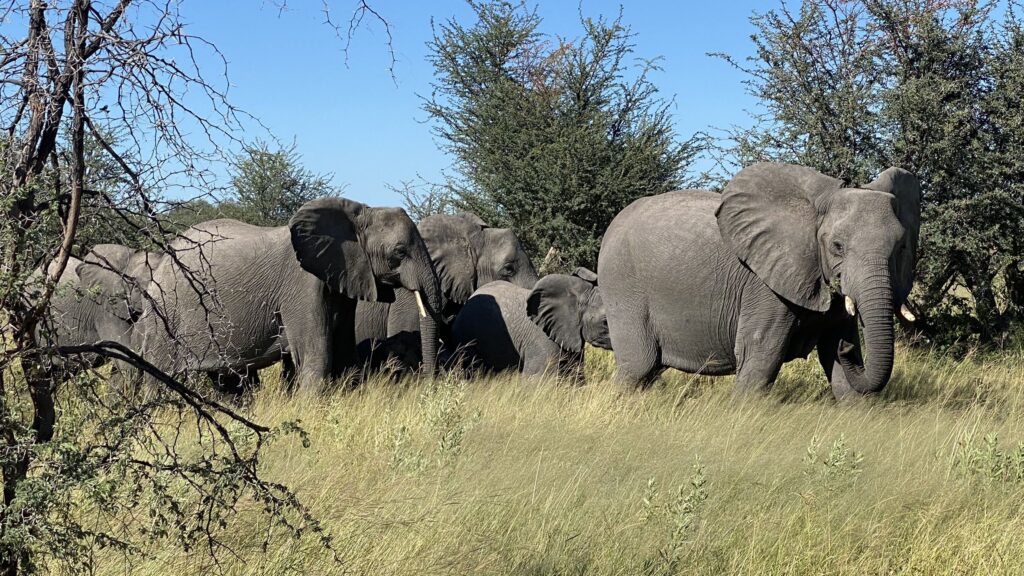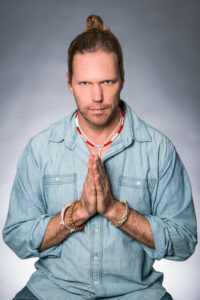Have you ever been moved by a particular smell, birdsong or wild animal, like a roaring lion, that left you feeling alive? The smell and sound captivated your senses and alerted you to something sublime and mystical on the edge of your senses. Or maybe you experienced a particular dream that had you gasping for air like a fish out of water. The dream gave you pins and needles, an electric shock down your spine, reminding you of something deeper beyond your understanding. The last frontier or unexplored space could be closer than we think; the space between waking and sleep or between each heart beat. That space could be as fleeting as a newborn’s wink or a fledgling bird’s first flight. Pay attention! You might miss it. Nature is speaking to us in a language of signs, sometimes obvious, sometimes ellusive, but always changing. In our fast-paced digital era we are all being called back to nature, to ourselves and the world around us. Can you hear the wind in the trees? What is it saying to you? The answer to species extinction and deforestation resides inside each one of us. Between each breath and silent pause is a whisper of promise and opportunity, to turn the tide of the destruction of nature.
In order to save nature, we need to first save ourselves. We need to save ourselves from the overly domestic, sterile and obsessive conditioning of the modern world that turns the earth into dirt and desecrates the land. In my travels around the world, I am often amazed to hear people talk about the weather as if it is wrong and can be controlled. It is either too hot, too cold, too windy, too snowy etc. How would the world look if we befriended the weather outside and we learned to smile at a rainy day and laugh nervously at a thunderstorm? Our relationship with weather is a wonderful metaphor for our relationship with nature. If we can learn to befriend weather outside, then the next frontier is our inner weather of emotions like sadness, grief, anger and jealousy, that can turn a calm-mannered person into a hurricane of unexpressed rage. This dynamic we are all familiar with, which can escalate to violence and even war.
The call of the wild is the call to the deepest part of ourselves, our human nature. In sangoma circles we speak about ‘Ubuntu Ubunzulu’, the depth of humanity. Ubuntu means humanity. During my lengthy sangoma apprenticeship my Xhosa elders explained to me that people are born human but they have to decide to be a human being. To be a human being means to listen to the wind inside us (uMoya), honour our ancestors (bones) and connect with the divine (Qamata). These teachings are deep and affect the human world as well as plant and animal. Ubuntu speaks about a circle, a human circle of interconnectivity based on our shared red blood and ancestors. After we connect with one another then we are more available to connect with the outer wilderness in the form of plants and animals.
The first step in our Ubuntu journey is about connecting with our ‘uMoya’ (spirit wind) and feeling how it emanates our flesh and bones through its relationship with our heart, the little drummer in our chest. In the traditional sangoma world we feel our heart beat as the drum that awakens our ancestors. As we energise our heart with the breath of life, our ‘uMoya’, then we feed our consciousness in a mindful way. The journey of befriending our inner wilderness has begun; one step, one breath, one heartbeat…
The next part of our human journey of listening to the call of the wild involves honouring our bones in the form of our ancestors. Whether you like your ancestors or not is immaterial. The work is about honouring the bones that gave us life. As we do this, we awaken the primordial and ancient part of us. Remembering our dead is a vital part of being human and an essential part of answering the ‘call of nature’.
Every human being has a moment of revelation or epiphany when they feel something deeper than their flesh and bones, something eternal, ephemeral or divine. Call it an experience of the soul, that part of us that survives physical death, our immortality. It is the wildest, most untamed part of ourselves. It is connected to nature in the rawest, most intimate way. I witnessed this firsthand during sangoma rituals in the Eastern Cape when young initiates would accept their calling and this would often involve either tears of joy, uncontrolled shaking or a primal scream that loosened the layers of ordinary and extraordinary. After we accepted our calling, the sangoma drum would usher in a hurricane of energy, of thunder and lightning rising to a crescendo on the waves of the community’s chants. I experienced my own calling in this way, where I had to answer to the ‘call of the wild’ inside me. It was and continues to be exquisitely beautiful, painful and challenging. Why? Because we are intimately connected to nature. As we wake up, we become profoundly sensitive and empathic. As nature thrives, we thrive. As nature hurts, we hurt. This is the default of being a human being.
Some of the deepest and most profound moments of my life have been during sangoma ceremonies where the drums call our spirits home. A sangoma intlombe or ‘trance dance’ is one of the wildest experiences for a human being, like extreme surfing down 40 ft waves or climbing Mount Everest. As I am dancing my heart beats over 200 beats a minute and my body is transported to another world. It is painful physically and then the wilderness speaks through the heart and the drum in a language beyond words… The energy of a sangoma ceremony builds as the drum and voices of the people merge with an electrical intensity that permeates the room. I often think of one particular ceremony years ago where I could feel the drum beat in the walls of the house. Everything was pulsing, moving, swaying. We, as a community of sangomas, traditional healers, township dwellers and human beings were saying “yes” to connecting with our bones (ancestors), uMoya (wind inside) and collective community. And we said “yes” with our voices, our feet and our hands. People were alive, and, in that moment, time stood still and nature moved closer.
Often our sangoma ceremonies would be greeted by literal thunder and lightning outside the ceremonial room. In these moments our elders would quietly exclaim:“Izinyanya zivumile”. The ancestors have agreed, or accepted our prayers. They have blessed us and opened our wild human journey to another level of consciousness, like another layer of the alchemical onion.
During my recent retreats in the Kalahari Desert with San Bushmen I was happy to experience the ‘shaking medicine’ or trance dance in the Bushmen way. The style of dancing is similar to my South African sangoma community. With the focus being on the feet and spine, the work is about shaking the spine in a reflexive, natural way. We have to get out of our heads and let the primal wilderness of our bodies speak in the language of rhythm. The trance dance is very simple and it starts with walking. I noticed my San tracker friends moving through the bushveld like dancers caressing the earth with fluidness and ease. With my own walking I touched the trance state whilst walking in a rhythmical way, listening to my body, keeping my spine straight and looking at the horizon. As I listened to the sounds around me, gazed at the horizon and brought the breath through my body, I experienced the ‘!Xum’ as the bushmen shared with us; that sense of electrical energy that moves the stars.
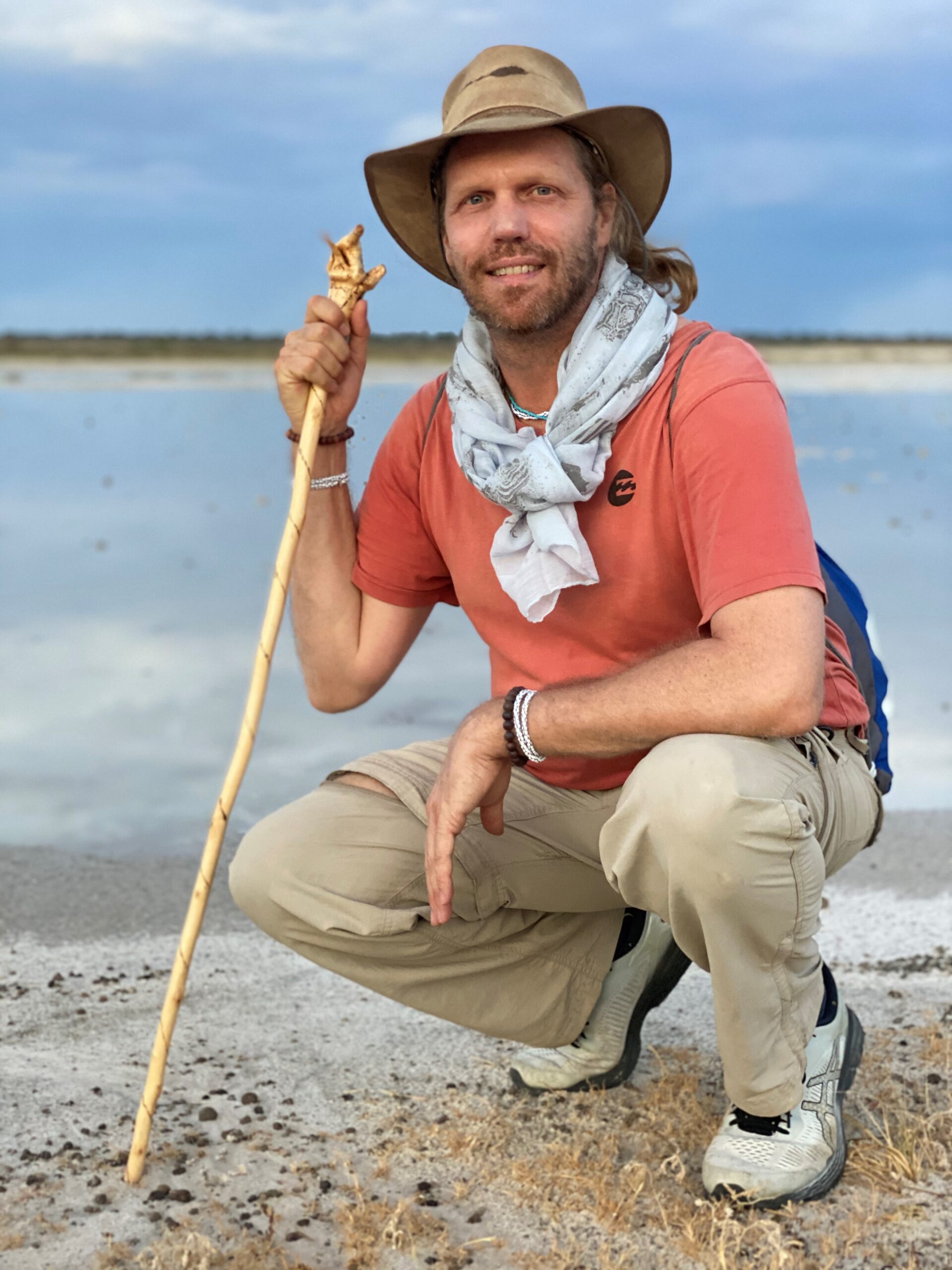
The journey of listening to the wind and answering the ‘call of the wild’ wouldn’t be complete without talking about the shadow, the ever-present and silent witness in our human world. As we dance, pray and invoke our ancestors, our spine heats up. It is a physical experience. The heat of our spine also heats up our emotional body. In the sangoma world our elders caution us about expressing strong emotions like anger during ceremony. It brings to mind an old African saying that uninitiated men can burn the village down. Why? Because they can’t contain the wildness of human emotion. It seems like our world is running amok with uncontrolled emotions. The Ubuntu journey needs to incorporate befriending our personal shadow. Each person is responsible for listening to their feelings. During ‘umsebenze’ or a sangoma ceremony, emotion is seen as a part of life. If people don’t feel anything, then they are encouraged to approach one of the sangoma elders. Often strong and painful emotions are a sign that the medicine of the ceremony, of the dance, is working. In our modern world we blame incessantly, making politicians, leaders and other people responsible for our feelings. In an indigenous world this would be the mark of a child, adolescent or uninitiated person. A mature response is to allow the feelings to filter through the body, to nourish and condition the spine. This is alchemy, the medicine of transformation. Life initiates us whether we live in New York City or the heart of the Kalahari Desert. How do we respond to the trials and challenges of life? That is most important! We are all called nowadays to walk like warriors, face the horizon and open our spine to the stars. When we do this with courage and love then anything is possible and nature is right there with us as a silent friend, lover and companion.
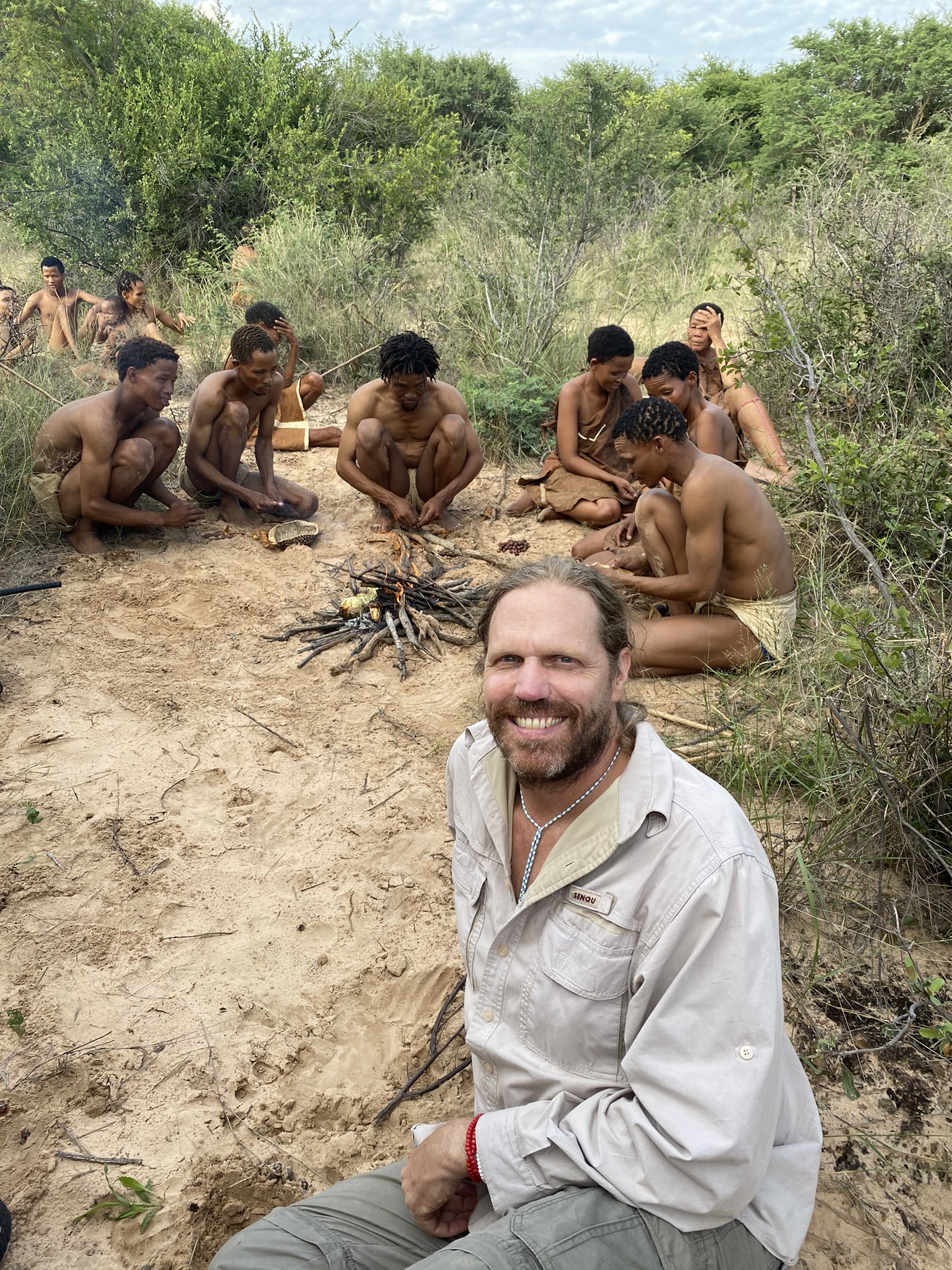
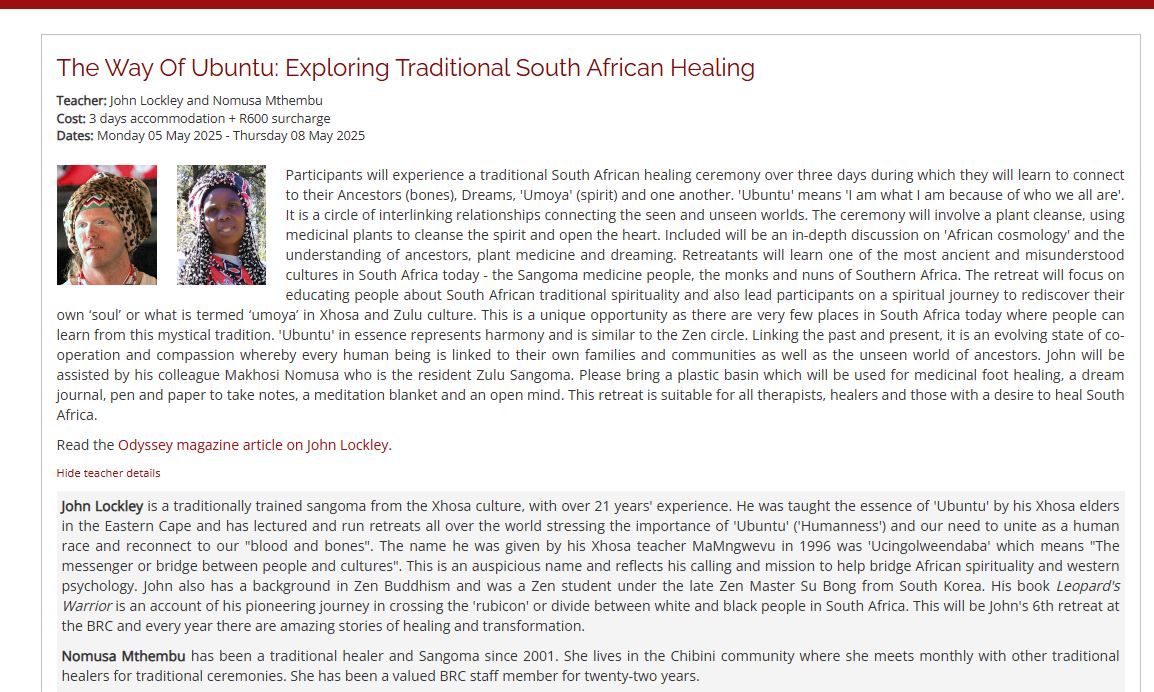
John Lockley is a traditionally trained sangoma in the Xhosa and Swazi lineages. He apprenticed for 10 years under MaMngwevu, a Xhosa sangoma in the Eastern Cape. He has pioneered the bridge between modern western psychology and traditional South African spirituality. His Xhosa name given by his teacher is ‘Ucingolweendaba’ meaning ‘the messenger’ or ‘bridge between people’. For the last 13 years he has been facilitating ‘Ubuntu’ (humanity) and ‘Way of the Leopard’ retreats worldwide, teaching people how they can reconnect to their ancestors, spirit and the earth. John’s passion is teaching people indigenous African medicine to help them reconnect to the earth. He facilitates this through his ‘Dreams and Tracking’ retreats in the Kalahari Desert every year and his retreats at the
Buddhist Retreat Centre (BRC) in Ixopo, KwaZulu-Natal, South Africa. John’s bestselling book Leopard Warrior and audio teaching course ‘Way of the Leopard’ are both produced by Sounds True and available in leading bookstores, Amazon and Kindle. You can also get it directly via John’s website: https://www.johnlockley.com/press.
John is a public speaker and is often requested to speak on international podcasts with a focus on African and spiritual themes like Ubuntu and our relationship with the environment. John can be contacted via his website for speaking engagements.
John will be leading another series of retreats in the Kalahari Desert in 2024 followed by ‘Leopard Warrior Trails’ in May in South Africa. He will also be running an intensive three day Ubuntu retreat at the BRC from 26th – 29th April 2024. Visit John’s website for more information, or to sign up for his newsletter: https://www.johnlockley.com.

